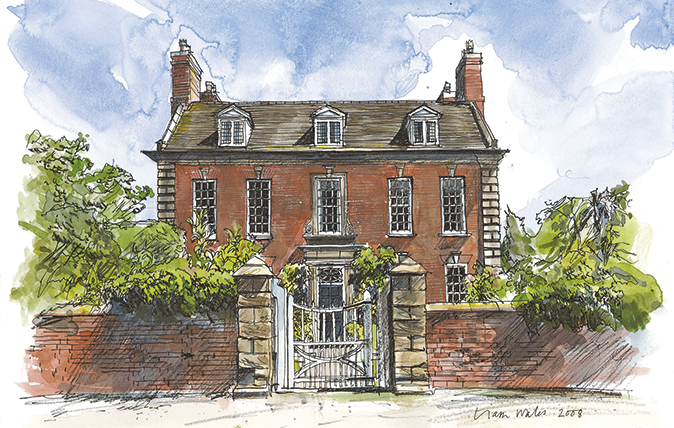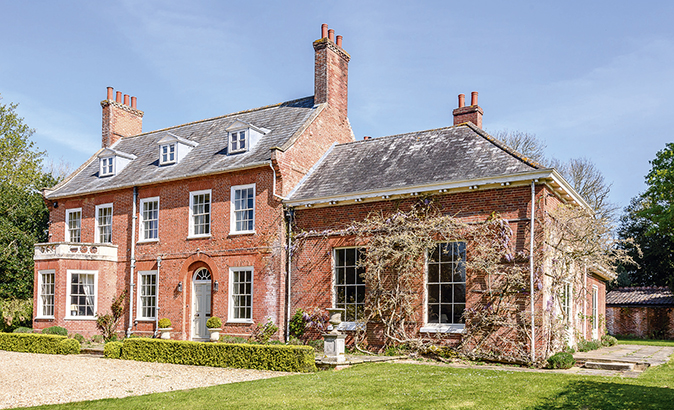More tea, vicar? The persistent appeal of the parsonage
Dearly beloved, the parsonage’s appeal never falters, finds Eleanor Doughty.


Never mind mind big, crumbling piles with more bedrooms than you have second cousins, the English parsonage provides a perfectly sized slice of idyllic country life. With features such as well-proportioned rooms, a central village location and lush, green gardens, it’s easy to see why more than just vicars are drawn to these charming properties and their popularity has never really waned. After all, parsonages—a term that describes both vicarages and rectories— are possessed with, as Catherine Morland put it in Northanger Abbey, ‘unpretending comfort’.
| Pining for a parsonage?What to readThe Murder at the Vicarage by Agatha ChristieThe Vicar of Nibbleswicke by Roald DahlBarchester Towers by Anthony TrollopeThe Rector’s Wife by Joanna TrollopeLark Rise to Candleford by Flora ThompsonWhat to watchKeeping Mum (2005), in which Rowan Atkinson plays a reverend who, unwittingly, has his murderous mother-in-law (Maggie Smith) to stayITV’s Grantchester, from the novels by Archbishop’s son James Runcie, in which Anglican-vicar-cum-amateur-sleuth Sidney Chambers (James Norton) helps an overworked policeman solve crimes |
However, not all parsonages were made equal. Many fit the ‘Georgian box’ archetype, but others come in altogether more Victorian, even modern, garb. Writer Anthony Jennings, director of Save Our Parsonages, describes them as ‘perhaps the most admirable, desirable and aesthetic body of domestic buildings ever built’ in his book The Old Rectory: the story of the English parsonage.
Agents tend to be thrilled when a rectory comes onto the market. They’re the ideal family home, believes Luke Pender-Cudlip, head of Knight Frank’s Sherborne office (01935 810062). ‘A lot of people don’t want the huge house with 12 bedrooms. If you have two or three children, a rectory can be a good size.’ Geographically, they’re spot on, too. ‘They’re usually next to a church and, therefore, you have all the benefits of village life, a local pub and perhaps a school,’ says Mr Pender-Cudlip.
Mark Peck, director of Cheffins, the Cambridgeshire-based agency, agrees (01353 654900). ‘With imposing locations and generous gardens and grounds, old rectories are often the best property in the village. They continue to represent the archetypal village house for many buyers.’ The P. G. Wodehouse England perception helps. ‘For many, they conjure up images of croquet matches on the lawn with cucumber sandwiches,’ explains Mr Peck, who’s recently sold a former vicarage in Soham on behalf of the Ely Diocese.
The parsonage is also an understated social marker. ‘They capture in elegantly built poetry the position of many wealthy individuals,’ says architect Robbie Kerr of ADAM Architecture, who grew up spending time at a charming Queen Anne rectory in Stanford-in-the-Vale, Oxfordshire. ‘The church lay at the heart of the community and those running it were often well disposed, with time to explore architectural taste and refine their home into beautiful buildings of the latest fashion.’ Often, Mr Kerr says, they were ‘built without constraint’.
In a social context in which the eldest son would inherit the estate, the second would join the Army and the third would go into the Church, the vicarage needed to be sturdy. ‘If you were the son of a rich family, you weren’t going to go and live in a tiny little property—you would be living in a fine house,’ says Lindsay Cuthill, head of Savills’ country-house department (020– 7016 3820). ‘You start, through that historical context, having very well designed, substantial houses for people of means.’
Novelist Jeffrey Archer has lived in his rectory in Grantchester, Cambridgeshire, for 30 years. The village has three—the old one belonging to the Archers and immortalised in Rupert Brooke’s 1912 nostalgic poem The Old Vicarage, Grantchester, the middle vicarage and, now, a modern one. The Archers’ house, which dates back to 1683, has a 3½-acre garden with mature trees, a lake and front lawn (Country Life, April 15, 2015). Inside, it’s ‘the perfect size,’ says Lord Archer. ‘We’ve got a kitchen, a utility room, a dining room, a drawing room and a study and, upstairs, a television room and five bedrooms. You can’t look at it and not think “what a lovely house”.’
Sign up for the Country Life Newsletter
Exquisite houses, the beauty of Nature, and how to get the most from your life, straight to your inbox.
The financial premium on parsonages is difficult to pinpoint, but agents estimate it to be about 10%– 20%. In any case, demand outstrips supply; it’s not every day that rectories come up for sale.
Those parsonages that come without lots of land divide buyers, says Mr Cuthill. ‘A high-profile celebrity may love the look of a rectory, but feel unable to buy it because it’s visible from the street. A lot of rectories had a separate door onto the garden for parishioners to come and visit; that means easy access. If you want somewhere very private, it might not be the property for you.’
Luckily, for the rest of us, a parsonage is pretty close to perfect.
Buy your own perfect parsonage

An eight-bedroom Grade II*-listed rectory has come to the market in Lower Brailes, Warwickshire, with Knight Frank at £2 million (01789 867 263). Parts date back to the 14th century and, inside, its exposed timbers, sash windows and oak staircases are to be admired. The gardens total 1.2 acres laid to lawn and are accompanied by a south-facing terrace
- - -

Closer to the Georgian ideal is The Old Rectory in Norwich, a handsome Grade II-listed country house with secluded gardens, on the market with Savills at £1.65 million (01603 229229). Some of the house was built in 1735 and it boasts a Victorian drawing-room addition
Country Life is unlike any other magazine: the only glossy weekly on the newsstand and the only magazine that has been guest-edited by HRH The King not once, but twice. It is a celebration of modern rural life and all its diverse joys and pleasures — that was first published in Queen Victoria's Diamond Jubilee year. Our eclectic mixture of witty and informative content — from the most up-to-date property news and commentary and a coveted glimpse inside some of the UK's best houses and gardens, to gardening, the arts and interior design, written by experts in their field — still cannot be found in print or online, anywhere else.
-
 Vertigo at Victoria Falls, a sunset surrounded by lions and swimming in the Nile: A journey from Cape Town to Cairo
Vertigo at Victoria Falls, a sunset surrounded by lions and swimming in the Nile: A journey from Cape Town to CairoWhy do we travel and who inspires us to do so? Chris Wallace went in search of answers on his own epic journey the length of Africa.
By Christopher Wallace Published
-
 A gorgeous Scottish cottage with contemporary interiors on the bonny banks of the River Tay
A gorgeous Scottish cottage with contemporary interiors on the bonny banks of the River TayCarnliath on the edge of Strathtay is a delightful family home set in sensational scenery.
By James Fisher Published
